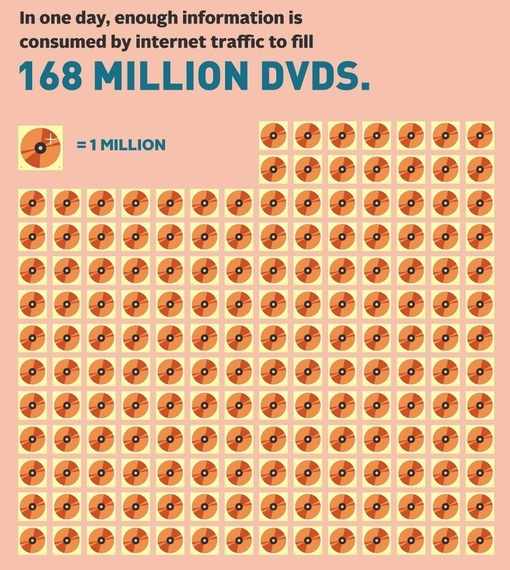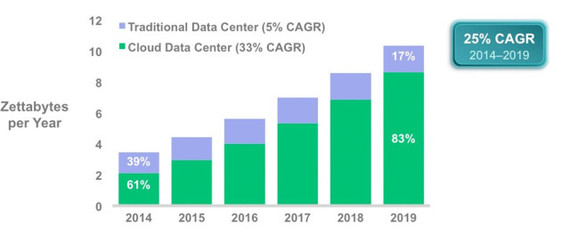The cloud is a commonplace technological fixture in our lives today, so much so that it's almost become a colloquial joke for this nebulous magical service that allows you to store your files somewhere other than your own hard drive. Where are all my pictures and videos? Oh, they're up in the cloud. Where is the cloud? I have no idea. Above our heads?
Of course, the reality of the cloud is much simpler, one that has become an increasingly important topic of conversation in the tech world. Basically, data still has to be stored on a server somewhere, and cloud service companies simply offer you the luxury of storing your things on their servers, instead of having to sink a bunch of money into your own storage space. So, when you say "the cloud," you probably mean an enormous warehouse in the middle of nowhere full of servers that communicate with your devices and store your files so you can keep that precious space on your personal hard drive free.
These enormous warehouses, a.k.a. data centers, are being scrutinized more and more recently, mainly for two reasons. One, they can cost a lot of money, not only to set up but to keep running, and two, they use an enormous amount of power, with some estimates suggesting that a large scale industrial data center for major U.S. companies such as Google, Amazon, and Microsoft can use as much as electricity as most small towns. This doesn't bode well for the environmental impact of data centers; in
fact, statistics suggest that nearly 20% of all technology's carbon footprint comes from these huge data centers around the world.
What complicates this issue even further is that the world of technology users shows no signs of slowing down their data usage. In fact, reports indicate that upwards of 90% of the world's total data has been created in just the past two years. If you break that down, the amount of data used in one day of internet traffic would fill up 168 million DVDs. What's more, Cisco is projecting that global data center traffic will grow threefold every year through 2019, with projections looking even more staggering beyond that.
Compounding this issue even further is the fact that major companies are cooking up more and more innovative new ways to utilize the analytics of big data, including everything from business intelligence to predictive social network analysis. Companies whose whole model stands on cloud-based analytics services are popping up in record numbers, including supply chain management and HR solutions and social media scraping geared to improving business outcomes.
It's clear, then, that the world's tech leaders need to find a more efficient way to operate data centers, or else risk succumbing to catastrophic environmental and economic repercussions. While there are some encouraging signs of progress coming from the tech industry giants, such as Facebook's completely wind-powered data center and Google's large-scale effort to use renewable energy to help power their data centers, the fear of too-little-too-late still hangs like a cloud over the future, especially as more and more usages of data materialize.
The two-year-old startup Shryne, for example, is implementing a vision of the cloud on a massive scale, having just rebranded themselves in their recent 2.0 version launch as a cloud-based archive of all of one's personal communications, from text messages to tweets to emails on your old college email address. While texts and emails alone might not take up that much storage space, imagine the proliferation of businesses that would pop up offering analytical services for Shryne's "personal cloud" model.
Another sector expected to massively increase its chunk of cloud-based data in the near future is the ever-growing Internet of Things. As more cars and buildings and streetlights and all other machines begin communicating with each other more and more, experts are predicting that data from IoT-related apps could quickly gobble up an enormous chunk of data center storage space, with some projections for 2019 suggesting that data from IoT apps could severely outpace the projections for total data center traffic.
If these projections prove even close to true, then data centers need a serious facelift, one much more drastic than the commendable renewable and green efforts of major tech giants. Cloud computing is quickly going from a luxury that frees up personal users' storage to a necessity to keep up with the amount of information we are consuming every day.
Luckily, some sharp teams are already cooking up groundbreaking solutions to our growing data storage problem. A team at Microsoft, for example, is working on the launch of Project Natick, an initiative designed to deploy underwater data centers.
The reasoning behind this innovative idea is mainly twofold: an enormous percentage of the world's population lives close to large bodies of water, and the underwater environment provides cheap, sustainable methods for cooling the servers, a process which takes up a large chunk of any data center's operating costs. Whether this solution can be scaled up to the massive levels the world's data demand needs remains to be seen, but it's certainly a step in the right direction.
It is known and well-documented that it is possible to reach an absolute maximum limit for data storage. The world could quickly become a very different place if that were to happen, so for now, it's crucial that tech companies do their users and themselves a favor and begin investing heavily in more sustainable data storage solutions.



